The Mechanical Properties of Silicone Rubber Composites with Shear Thickening Fluid Microcapsules
Abstract
1. Introduction
2. Materials and Methods
2.1. Materials
2.2. SiO2 Preparation
2.3. STF Preparation
2.4. SR/STF Composites Preparation
2.5. Characterization
3. Results and Discussion
3.1. Microstructural Characteristics of SiO2
3.2. Rheological Behavior of STF
3.3. Microstructure of SylSR/STF Composites
3.4. Mechanical Properties and Impact Resistance Behavior of SylSR/STF Composites
4. Conclusions
- (1)
- The damping properties of silicone rubber can be enhanced by the addition of STF and the increase of the fraction of the STF increases the value of Tan δ.
- (2)
- The SR/STF composites presented decreased stiffness and an obvious strain rate effect at low strain rates (from 0.5 mm/min to 200 mm/min) in quasi-static compression experiments.
- (3)
- The addition of STF can improve the impact protection performance of silicone rubber and the impact resistance increased with the increase in the STF mass fraction.
- (4)
- The enhancement effect of STF on the impact resistance of silicone rubber is influenced by the strength of the silicone rubber matrix. The stronger the strength of silicone rubber, the better the effect of STF on improving the impact protective performance of the silicone rubber.
Author Contributions
Funding
Institutional Review Board Statement
Informed Consent Statement
Data Availability Statement
Acknowledgments
Conflicts of Interest
Abbreviations
| SylSR | Sylgard 184 silicone rubber |
| HTVSR | hot vulcanized silicone rubber |
| STF | shear thickening fluid |
| MVMQ | methyl vinyl silicone rubber |
| DCP | dicumyl peroxide |
| OM | optical microscope |
| FE-SEM | field-emission scanning electron microscopy |
| DMA | dynamic thermo-mechanical analysis |
References
- Peters, I.R.; Majumdar, S.; Jaeger, H.M. Direct observation of dynamic shear jamming in dense suspensions. Nature 2016, 532, 214–217. [Google Scholar] [CrossRef] [PubMed]
- Liu, H.; Fu, K.; Cui, X.; Zhu, H.; Yang, B. Shear Thickening Fluid and Its Application in Impact Protection: A Review. Polymers 2023, 15, 2238. [Google Scholar] [CrossRef] [PubMed]
- Wei, M.; Lin, K.; Sun, L. Shear thickening fluids and their applications. Mater. Des. 2022, 216, 110570. [Google Scholar] [CrossRef]
- Zarei, M.; Aalaie, J. Application of shear thickening fluids in material development. J. Mater. Res. Technol. 2020, 9, 10411–10433. [Google Scholar] [CrossRef]
- Zhang, X.Z.; Li, W.; Gong, X. The rheology of shear thickening fluid (STF) and the dynamic performance of an STF-filled damper. Smart Mater. Struct. 2008, 17, 035027. [Google Scholar] [CrossRef]
- Wang, L.; Du, Z.; Fu, W.; Wang, P. Study of mechanical property of shear thickening fluid (STF) for soft body-armor. Mater. Res. Express 2021, 8, 045021. [Google Scholar] [CrossRef]
- Roché, M.; Myftiu, E.; Johnston, M.C.; Kim, P.; Stone, H.A. Dynamic Fracture of Nonglassy Suspensions. Phys. Rev. Lett. 2013, 110, 148304. [Google Scholar] [CrossRef]
- Moon, J.Y.; Dai, S.; Chang, L.; Lee, J.S.; Tanner, R.I. The effect of sphere roughness on the rheology of concentrated suspensions. J. Non-Newton. Fluid Mech. 2015, 223, 233–239. [Google Scholar] [CrossRef]
- Wu, X.; Zhong, F.; Yin, Q.; Huang, C. Dynamic response of shear thickening fluid under laser induced shock. Appl. Phys. Lett. 2015, 106, 071903. [Google Scholar] [CrossRef]
- Wu, X.; Yin, Q.; Huang, C. Experimental study on pressure, stress state, and temperature-dependent dynamic behavior of shear thickening fluid subjected to laser induced shock. J. Appl. Phys. 2015, 118, 173102. [Google Scholar] [CrossRef]
- Li, W.; Xiong, D.; Zhao, X.; Sun, L.; Liu, J. Dynamic stab resistance of ultra-high molecular weight polyethylene fabric impregnated with shear thickening fluid. Mater. Des. 2016, 102, 162–167. [Google Scholar] [CrossRef]
- Gürgen, S.; Kuşhan, M.C. The stab resistance of fabrics impregnated with shear thickening fluids including various particle size of additives. Compos. Part A Appl. Sci. Manuf. 2017, 94, 50–60. [Google Scholar] [CrossRef]
- Mawkhlieng, U.; Majumdar, A. Deconstructing the role of shear thickening fluid in enhancing the impact resistance of high-performance fabrics. Compos. Part B Eng. 2019, 175, 107167. [Google Scholar] [CrossRef]
- Zhang, H.; Zhang, X.; Chen, Q.; Li, X.; Wang, P.; Yang, E.H.; Duan, F.; Gong, X.; Zhang, Z.; Yang, J. Encapsulation of shear thickening fluid as an easy-to-apply impact-resistant material. J. Mater. Chem. A 2017, 5, 22472–22479. [Google Scholar] [CrossRef]
- Zhang, X.; Zhang, H.; Wang, P.; Chen, Q.; Li, X.; Zhou, Y.; Gong, X.; Zhang, Z.; Yang, E.H.; Yang, J. Optimization of shear thickening fluid encapsulation technique and dynamic response of encapsulated capsules and polymeric composite. Compos. Sci. Technol. 2019, 170, 165–173. [Google Scholar] [CrossRef]
- Liu, X.; Huo, J.L.; Li, T.T.; Peng, H.K.; Lin, J.H.; Lou, C.W. Investigation of the Shear Thickening Fluid Encapsulation in an Orifice Coagulation Bath. Polymers 2019, 11, 519. [Google Scholar] [CrossRef]
- Kaczorowski, M.; Ronowicz, M.; Rokicki, G. Organogels containing immobilized shear thickening fluid and their composites with polyurethane elastomer. Smart Mater. Struct. 2019, 28, 035034. [Google Scholar] [CrossRef]
- Soutrenon, M.; Michaud, V. Impact properties of shear thickening fluid impregnated foams. Smart Mater. Struct. 2014, 23, 035022. [Google Scholar] [CrossRef]
- Soutrenon, M.; Michaud, V.; Manson, J.A. Influence of Processing and Storage on the Shear Thickening Properties of Highly Concentrated Monodisperse Silica Particles in Polyethylene Glycol. Appl. Rheol. 2013, 23, 54865. [Google Scholar]
- Shit, S.C.; Shah, P. A Review on Silicone Rubber. Natl. Acad. Sci. Lett. 2013, 36, 355–365. [Google Scholar] [CrossRef]
- Zhu, J.Q.; Gu, Z.P.; Liu, Z.P.; Zhong, F.C.; Wu, X.Q.; Huang, C.G. Silicone rubber matrix composites with shear thickening fluid microcapsules realizing intelligent adaptation to impact loadings. Compos. Part B Eng. 2022, 247, 110312. [Google Scholar] [CrossRef]
- Kaewpradit, P.; Kongchoo, A.; Chonlathan, P.; Lehman, N.; Kalkornsurapranee, E. Impact absorbing kneepad prepared from natural rubber. IOP Conf. Ser. Mater. Sci. Eng. 2020, 773, 012063. [Google Scholar] [CrossRef]
- Li, G.; Zhao, T.; Zhu, P.; He, Y.; Sun, R.; Lu, D.; Wong, C.-P. Structure-property relationships between microscopic filler surface chemistry and macroscopic rheological, thermo-mechanical, and adhesive performance of SiO2 filled nanocomposite underfills. Compos. Part A Appl. Sci. Manuf. 2019, 118, 223–234. [Google Scholar] [CrossRef]
- Zhu, M.; Yang, C.; Han, T.; Hu, C.; Wu, Y.; Si, T.; Liu, J. An encapsulation–reduction–catalysis confined all-in-one microcapsule for lithium–sulfur batteries displaying a high capacity and stable temperature tolerance. Mater. Chem. Front. 2021, 5, 4565–4570. [Google Scholar] [CrossRef]
- Wang, Q.; Wang, S.; Chen, M.; Wei, L.; Dong, J.; Sun, R. Anti-puncture, frigostable, and flexible hydrogel-based composites for soft armor. J. Mater. Res. Technol. 2022, 21, 2915–2925. [Google Scholar] [CrossRef]
- Santiago-Alvarado, A.; Cruz-Felix, A.; González-García, J.; Sánchez-López, O.; Mendoza, A.; Hernández-Castillo, I. Polynomial fitting techniques applied to opto-mechanical properties of PDMS Sylgard 184 for given curing parameters. Mater. Res. Express 2020, 7, 045301. [Google Scholar] [CrossRef]



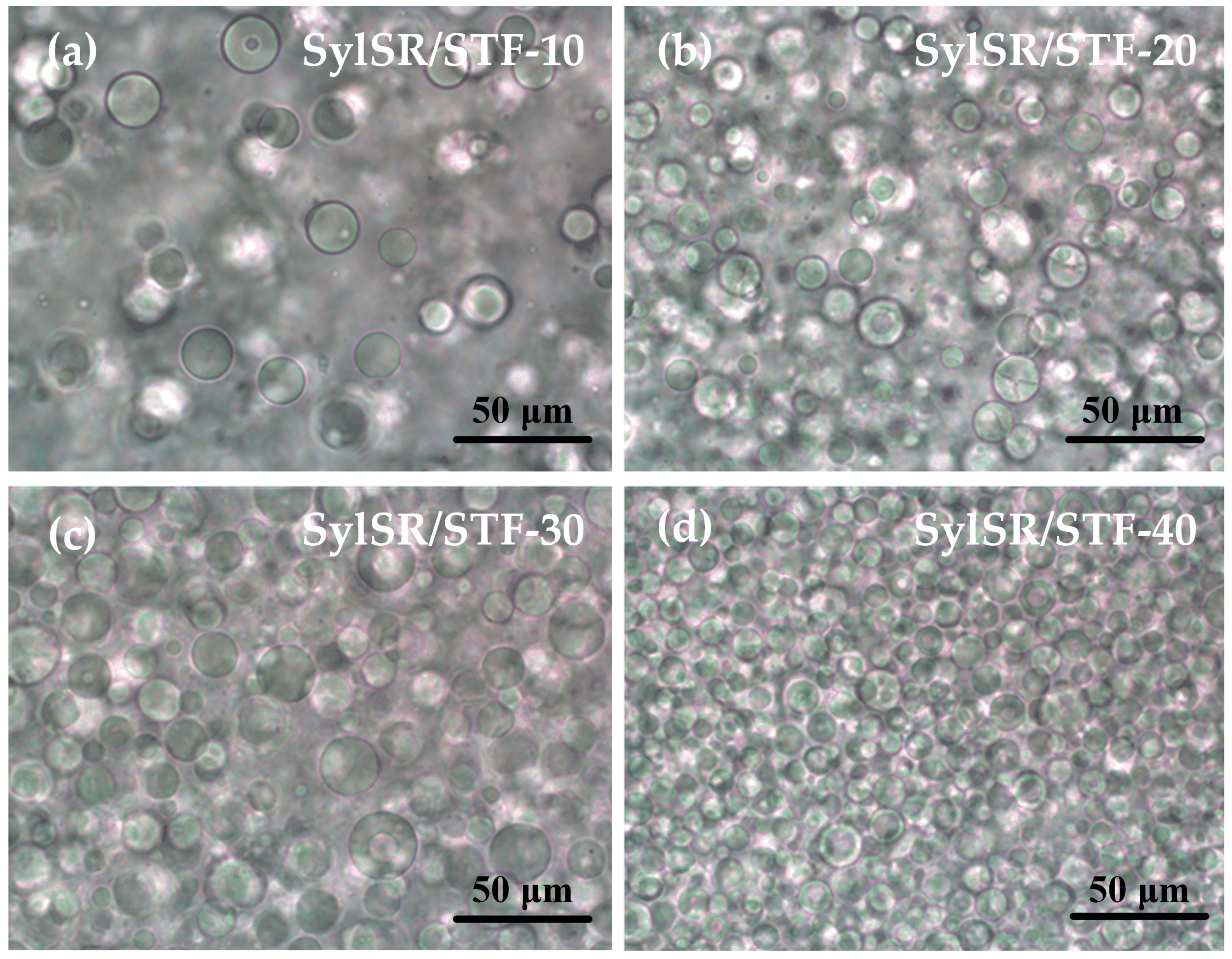
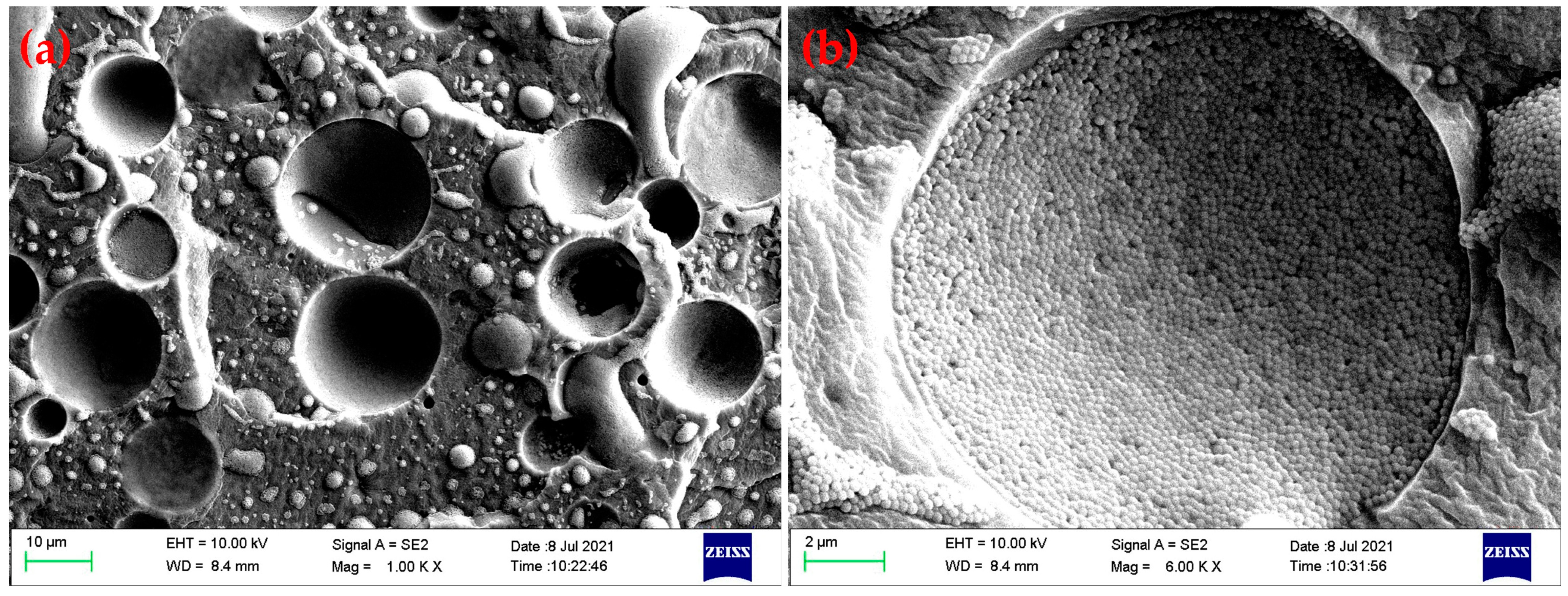

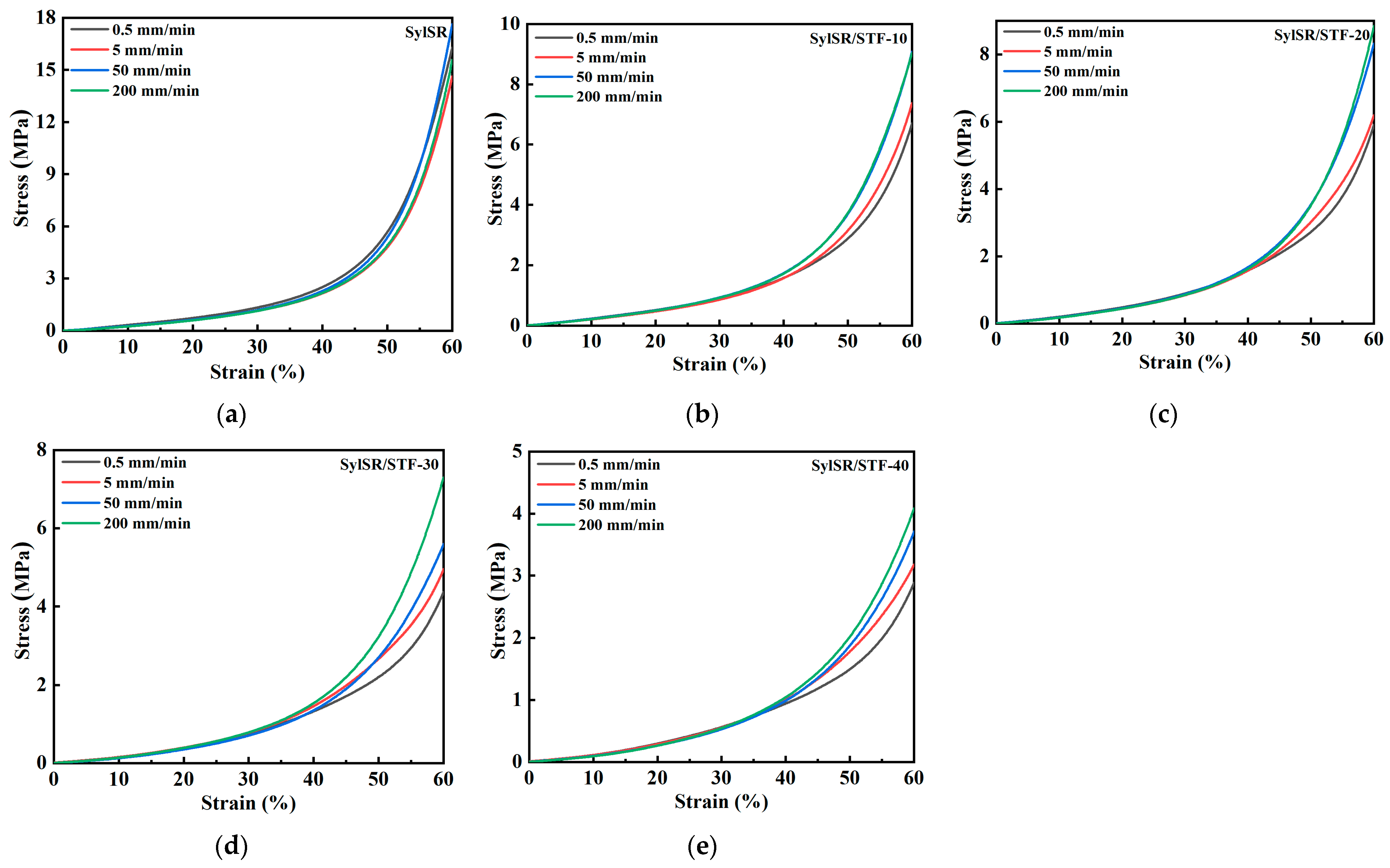

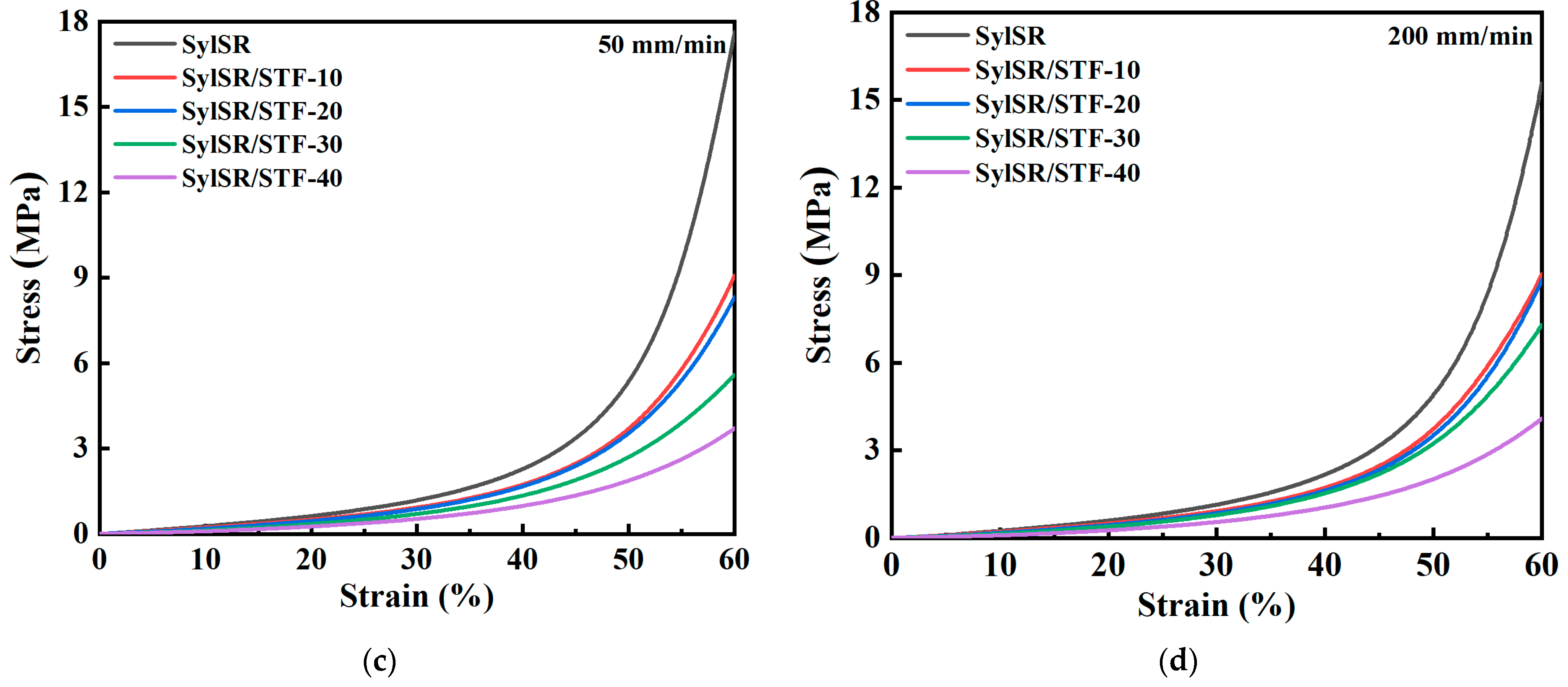
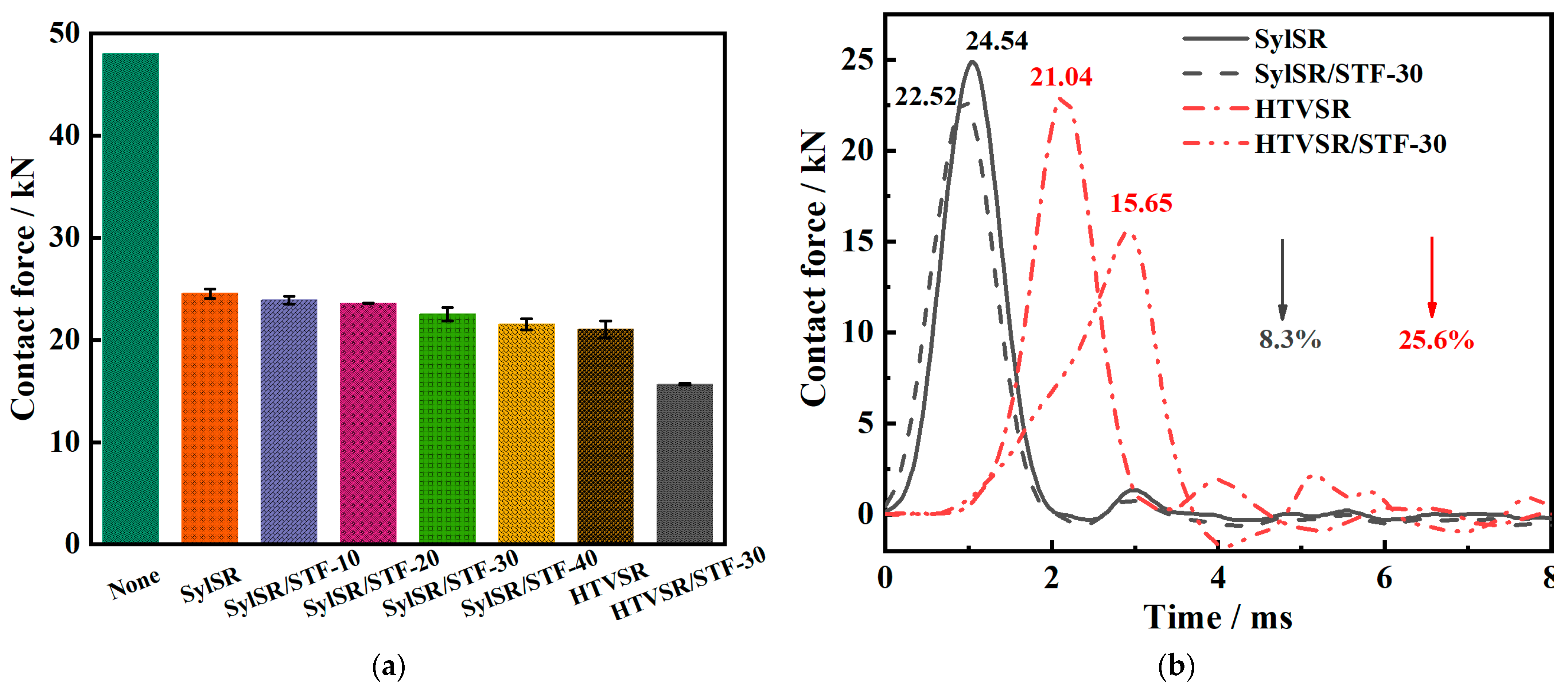
Disclaimer/Publisher’s Note: The statements, opinions and data contained in all publications are solely those of the individual author(s) and contributor(s) and not of MDPI and/or the editor(s). MDPI and/or the editor(s) disclaim responsibility for any injury to people or property resulting from any ideas, methods, instructions or products referred to in the content. |
© 2023 by the authors. Licensee MDPI, Basel, Switzerland. This article is an open access article distributed under the terms and conditions of the Creative Commons Attribution (CC BY) license (https://creativecommons.org/licenses/by/4.0/).
Share and Cite
Wei, C.; Hao, X.; Mao, C.; Zhong, F.; Liu, Z. The Mechanical Properties of Silicone Rubber Composites with Shear Thickening Fluid Microcapsules. Polymers 2023, 15, 2704. https://doi.org/10.3390/polym15122704
Wei C, Hao X, Mao C, Zhong F, Liu Z. The Mechanical Properties of Silicone Rubber Composites with Shear Thickening Fluid Microcapsules. Polymers. 2023; 15(12):2704. https://doi.org/10.3390/polym15122704
Chicago/Turabian StyleWei, Chun, Xiaofei Hao, Chaoying Mao, Fachun Zhong, and Zhongping Liu. 2023. "The Mechanical Properties of Silicone Rubber Composites with Shear Thickening Fluid Microcapsules" Polymers 15, no. 12: 2704. https://doi.org/10.3390/polym15122704
APA StyleWei, C., Hao, X., Mao, C., Zhong, F., & Liu, Z. (2023). The Mechanical Properties of Silicone Rubber Composites with Shear Thickening Fluid Microcapsules. Polymers, 15(12), 2704. https://doi.org/10.3390/polym15122704





